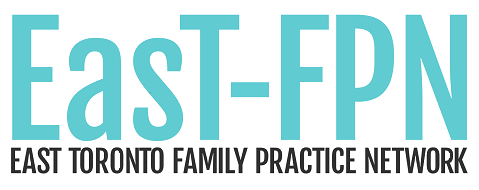Our Memorandum of Understanding
Background
The Interim Board of Directors of the EasT-FPN unanimously executed a Memorandum of Understanding (MOU), effective November 30, 2019, stating the conditions for the EasT-FPN supporting and joining the East Toronto Health Partners OHT application.
These conditions were incorporated into the Joint Venture Agreement, executed December 2, 2019, between:
Toronto East Health Network, operating as Michael Garron Hospital
Unity Health Toronto, operating as Providence Healthcare
South Riverdale Community Health Centre
VHA Home Healthcare
Woodgreen Community Services
East Toronto Family Practice Network (the EasT-FPN)
These six partners, including the EasT-FPN, are the anchor partners of the ETHP, one of the first Ontario Health Teams.
Understanding the MOU
The Interim Board of Directors worked to draft the MOU in an accessible way. Nevertheless, it’s a legal document and was the product of extensive negotiation, both internal and external, so some explanation can be helpful. What follows is a brief Q/A designed to address anticipated questions. Some nuances are glossed over below for the purpose of readability and simplicity; please refer to the actual document for details.
Who signed the MOU?
The MOU is a document that articulates the internal agreement of the EasT-FPN. Accordingly, it was only signed by the founding directors of the EasT-FPN. By signing the MOU, the EasT-FPN had a basis for in turn entering into the Joint Venture Agreement with the rest of the ETHP anchor partners.
See the first page of the MOU for further information, and the execution page for a listing of the individual board members who executed the agreement. They span the East Toronto region, and represent substantially all models of family practice.
what are the important parts of the MOU?
Schedule A lists 5 principles considered important statements to incorporate into the MOU. These statements articulate certain principles, such as the Patient’s Medical Home concept, the importance of primary care, the use of the Quadruple Aim framework, and the philosophy that equitable patient access to health care is important.
Schedule C lists a series of conditions believed critical to ensuring the long-term success of the ETHP. As mentioned, these were the conditions incorporated into the Joint Venture Agreement, as part of the negotiations around the EasT-FPN joining the ETHP as a sixth anchor partner.
What is the role of family practice and the EasT-FPN in the ETHP?
Section 1 of Schedule C lists the EasT-FPN’s conditions related to the governance of the ETHP. In general, these conditions are designed to ensure family practice has a strong, central, and permanent role in the ETHP and the design and delivery of health care in East Toronto. Notably:
The EasT-FPN is an anchor partner of the ETHP, equal to the other 5 original anchor partners.
The EasT-FPN has a veto over any other primary care organization joining the ETHP as an anchor partner. This was incorporated because family practice is already an extremely fragmented sector of the health care system; the belief is that family practice needs to have a single voice to be heard.
The EasT-FPN will have at least 2 representatives at the Leadership Group (of the ETHP). This was incorporated to ensure clinical representation at the Leadership Group as the belief is that a clinical point of view is extremely important.
Decisions at the Leadership Group will be by consensus, that is, decisions must be unanimous. This means the EasT-FPN has a veto over all decision (as do the other anchor partners of the ETHP).
The ETHP must always have, as an anchor partner, a self-governed group representing family practice. This was incorporated to ensure a permanent voice for family practice in the ETHP, irrespective of what might happen to the EasT-FPN as an organization.
This last bullet is particularly important. Given the youth of the EasT-FPN, the Interim Board of Directors felt strongly that the role of family practice in general is enshrined in the ETHP, not simply the role of the EasT-FPN.
Does family practice need to fund the EasT-FPN?
No. Everyone is well aware that family practice is not in a position to fund a new organization. Instead, Section 2 of Schedule C makes clear that that the whole of the ETHP will work together to secure ongoing funding for the EasT-FPN from the Ministry of Health.
Does family practice need to volunteer their time to support the East-FPN / ETHP?
The goal is to ensure family practitioners (and their staff / representatives) are fairly compensated when they participate in the governance, leadership and planning of the EasT-FPN / ETHP. Section 2.1 of Schedule C makes clear that part of the funding request for the EasT-FPN is for this specific purpose.
Put simply, it is unreasonable to expect individual practitioners to volunteer their time and to give up paid patient care hours in order to support health system reform and reorganization.
Will the ETHP control / set physician compensation?
Family physicians elected to the OMA helped found the EasT-FPN, so this issue was highlighted and prioritized.
The initial answer is that nothing in the Joint Venture Agreement or any other agreement gives the ETHP any control over the physician compensation, working hours, or workload. As the EasT-FPN has a veto over any decisions of the ETHP, this cannot change without the EasT-FPN’s agreement.
Out of an abundance of caution, Section 3 of Schedule C was added to speak to the hypothetical situation that the ETHP might, eventually, one day down the road, have a measure of control over family physician compensation. In such circumstances, the EasT-FPN made clear that its present position is that
the OMA shall continue to negotiate core physician compensation
any changes to family physician remuneration must be approved by the EasT-FPN
any changes to family physician remuneration must be consistent with OMA negotiated contracts
any changes to family physician hours, working conditions, and workload must be made collaboratively with all stakeholders
